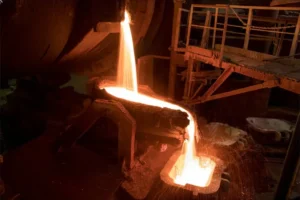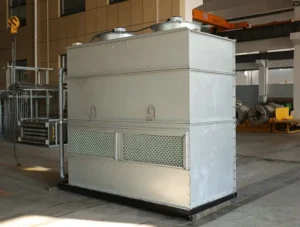“سوف ينطلق المنبه على أي حال”: فضح 5 المفاهيم الخاطئة القاتلة المتعلقة بالسلامة في تشغيل الفرن التعريفي

In the casting and metallurgical industries, medium-frequency induction furnaces are widely used for their efficiency and flexibility. لكن, their operating environment of high temperatures, high pressure, and strong electromagnetic fields is accompanied by significant safety risks. Although modern induction furnaces are equipped with multiple alarm systems, a complacent mindset of “the alarm will go off anyway” is quietly growing among some operators. This mindset can foster a series of fatal safety misconceptions, causing personnel to ignore critical danger signals and ultimately leading to catastrophic accidents.
ستكشف هذه المقالة عن أهم خمسة مفاهيم خاطئة تتعلق بالسلامة والتي يميل المشغلون إلى امتلاكها، كما ستعرض بالتفصيل إشارات الخطر الخفية التي تكمن وراءها, بهدف إصدار تحذير واضح للعاملين في الخطوط الأمامية.
فكرة خاطئة 1: الإنذار هو رصاصة فضية تحذر من كل الأخطار مقدمًا
إشارة الخطر: الإفراط في الاعتماد على أنظمة الإنذار الأوتوماتيكية لتسرب الفرن, ضغط المياه, ودرجة الحرارة, مع إهمال عمليات التفتيش الروتينية على المعدات وملاحظة الحالات الشاذة الدقيقة.
“يوجد إنذار لتسرب الفرن; سوف يبدو إذا كان الاختراق على وشك الحدوث.” هذا هو المفهوم الخاطئ الأكثر شيوعًا وخطورة. في الواقع, إنذار هو خط الدفاع الأخير للسلامة, ليست كرة بلورية للتنبؤ بالمخاطر. يعتمد مبدأ تشغيله في الغالب على اكتشاف التغيرات المفاجئة في تيار الحث أو مقاومة الأرض.
التفاصيل القاتلة التي تم التغاضي عنها:
- طبقة الإنذار: بحلول الوقت الذي يصدر فيه إنذار, غالبًا ما يكون الضرر الذي لحق ببطانة الفرن قد حدث بالفعل, وربما يكون المعدن المنصهر قد بدأ في حدوث تسرب بسيط. إنه على بعد خطوة واحدة فقط من وقوع حادث اختراق كبير. لا يمكن للإنذار التنبؤ بالترقق التدريجي للبطانة أو تشكيل الشقوق المحلية.
- إنذار النقاط العمياء: موضع تركيب مسبار الإنذار, إعدادات الحساسية الخاصة به, وسلامة نظام التأريض كلها تؤثر بشكل مباشر على موثوقيته. على سبيل المثال, إذا حدث تسرب خارج نطاق اكتشاف المسبار أو إذا كان التأريض السيئ يمنع إرسال الإشارة بدقة, قد يفشل نظام الإنذار تمامًا.
- ال “صرخة الذئب” تأثير: إمدادات الطاقة غير المستقرة, البيئات الرطبة, أو أن إعدادات المعلمة غير الصحيحة يمكن أن تسبب إنذارات كاذبة. يمكن للإنذارات الكاذبة المتكررة أن تضعف حساسية المشغلين, مما دفعهم إلى تجاهل إشارة الخطر الحقيقية باعتبارها مجرد إشارة أخرى “خلل في النظام.”
كيفية فضح ذلك: لا تضع ثقتك الكاملة أبدًا في نظام الإنذار. أصر على إجراء فحص بصري لبطانة الفرن بعد النقر على كل حرارة, الاهتمام بتغيرات اللون, الشقوق, تأليب, أو انتفاخ. ثق بخبرتك وحدسك; أي خلل بسيط يستحق الإغلاق للفحص.
فكرة خاطئة 2: إن التقلبات الصغيرة في ضغط/درجة حرارة مياه التبريد ليست مشكلة كبيرة
إشارة الخطر: تجاهل التأرجح الطفيف لإبرة قياس الضغط, انخفاض طفيف في قراءة مقياس التدفق, أو ارتفاع مستمر في درجة الحرارة عند مخرج كابل مياه التبريد.
المكونات الهامة للفرن التعريفي, مثل الملف التعريفي وكابلات الطاقة, الاعتماد على المياه المتداولة للتبريد القسري. Many operators only pay attention to whether the water pressure is below the alarm threshold, dismissing minor fluctuations.
التفاصيل القاتلة التي تم التغاضي عنها:
- The Story Behind a Minor Pressure Drop: A continuous, slight decrease in cooling water pressure may not be a normal pump fluctuation but could indicate a tiny, hard-to-find leak somewhere in the pipeline. If this leak point gets close to the furnace body or live electrical parts, it can easily trigger a short circuit or steam explosion.
- The Implication of Flow Changes: A small change in flow rate may signal a blockage or scale buildup in the pipes. If the blockage worsens, it will lead to localized overheating of the coil, damage to its insulation, and could even burn through the copper tube, causing a molten metal leak.
- The Warning from Outlet Temperature: يجب أن تكون درجات حرارة مخرج دوائر مياه التبريد المختلفة متوازنة نسبيًا. إذا كانت دائرة واحدة (وخاصة منفذ الملف التعريفي) يعمل باستمرار أكثر سخونة من غيرها, يشير إلى أن كفاءة التبريد آخذة في التناقص أو أن هناك نقطة ساخنة غير طبيعية في الجزء المقابل من الفرن - وهي علامة مباشرة محتملة على وجود بطانة رقيقة.
كيفية فضح ذلك: تعامل مع نظام مياه التبريد مثل الفرن “شريان الحياة.” إنشاء سجل تفتيش صارم, تسجيل ليس فقط قيم الضغط ودرجة الحرارة ولكن, والأهم من ذلك, هُم الاتجاهات. أي المستمر, وينبغي التحقيق في التغيير الطفيف غير المبرر على الفور.
فكرة خاطئة 3: طالما أن السلك الأرضي متصل, لا يهم مدى أمانه
إشارة الخطر: لا تتحقق مطلقًا من مدى إحكام توصيل السلك الأرضي, تبحث عن التآكل, أو فحص الكابل بحثًا عن أي ضرر.
يتم التأكيد بشكل متكرر على أهمية التأريض في العديد من معايير السلامة, ولكن في الممارسة العملية, إنها الشكليات الأكثر سهولة في التغاضي عنها. قد يعتقد المشغلون أن التأريض يهدف فقط إلى منع الصدمات الكهربائية, الفشل في فهم دورها الأساسي في مراقبة سلامة فرن الحث.
التفاصيل القاتلة التي تم التغاضي عنها:
- حجر الزاوية في أجهزة إنذار التسرب: مبدأ العمل في معظم أنظمة كشف تسرب الأفران هو اكتشاف حلقة التيار المتكونة بين المعدن المنصهر في قاع الفرن والمسبار الأرضي. إذا كان السلك الأرضي لديه اتصال فضفاض, اتصال ضعيف, أو المقاومة المفرطة بسبب الصدأ, يصبح نظام الإنذار بأكمله عديم الفائدة. عندما يلامس المعدن المنصهر المسبار, لا يمكن تشكيل إشارة فعالة, ومن الطبيعي أن يظل المنبه صامتًا.
- عائق أمام المعدات والأفراد: Proper grounding effectively prevents induced voltage from harming operators and control systems. With poor grounding, the furnace shell can carry dangerous induced currents, not only threatening operator safety but also interfering with electronic components, leading to control system failure.
كيفية فضح ذلك: Make checking the grounding system a mandatory part of the pre-start-up inspection. Shake the ground wire by hand to check its firmness; look for severe corrosion or burn marks at connection points; ensure the ground cable has no broken strands or damage. Periodically measure the ground resistance to ensure it meets safety code requirements.
فكرة خاطئة 4: The System is Highly Automated, So I Can Leave It to the Computer
إشارة الخطر: Walking away from the control console for long periods after initiating a one-button melting program, دون ملاحظة التغيرات في المعلمات الأساسية مثل التيار, الجهد االكهربى, والقوة.
حديث أفران التعريفي أصبحت آلية وذكية بشكل متزايد, مما يقلل بشكل كبير من كثافة اليد العاملة. ولكن هذا يقدم أيضًا خطرًا جديدًا: رضا المشغل بسبب الاعتماد على الأتمتة, مما يؤدي بهم إلى التنازل عن مسؤوليتهم في المراقبة والحكم النشط.
التفاصيل القاتلة التي تم التغاضي عنها:
- لا يمكن للأتمتة التعامل مع جميع الحالات الشاذة: يعمل البرنامج الآلي بناءً على معلمات محددة مسبقًا. عند حدوث ظروف شحن غير متوقعة (مثل المواد الكبيرة “سد,” الحجم المفرط) أو يتقلب جهد الشبكة بشكل غير طبيعي, قد لا يتخذ الكمبيوتر القرار الأمثل, مما يؤدي إلى ذوبان غير فعال أو حتى شذوذ في الطاقة يمكن أن يؤثر على بطانة الفرن.
- تجاهل التغيير التدريجي للمعلمات الأساسية: يمكن للمشغلين ذوي الخبرة الحكم على حالة ذوبان مادة الشحن وحالة البطانة من خلال مراقبة سرعة صعود منحنى الطاقة والعلاقة بين التيار والجهد. الاعتماد كليًا على الأتمتة يؤدي إلى فقدان هذه القيمة “يشعر” للفرن. على سبيل المثال, في قوة ثابتة, يعد ارتفاع الجهد المستمر والتيار المنخفض في مرحلة الانصهار المتأخرة علامة على وجود بطانة صحية; والعكس قد يشير إلى وجود مشكلة. يصعب على البرنامج الآلي أن يغطي هذه الارتباطات الدقيقة للمعلمات بشكل شامل.
كيفية فضح ذلك: تذكر دائمًا أن الأتمتة هي أداة مساعدة; المشغل البشري هو جوهر السلامة. حتى في الوضع التلقائي, قم بالعودة إلى وحدة التحكم بانتظام لمراقبة الأدوات الرئيسية للطاقة عن كثب, الجهد االكهربى, والحالية, ومقارنتها بالبيانات التاريخية. Combine instrument readings with the actual scene inside the furnace (flame color, molten metal agitation) to make informed judgments, achieving true “human-machine synergy.”
فكرة خاطئة 5: As Long as the Lining Isn’t Broken, It Can Be Used Indefinitely. No Need for Frequent Maintenance.
إشارة الخطر: Judging the service life of the furnace lining based solely on experience, without conducting scheduled lining thickness measurements or preventative minor repairs.
The furnace lining is the direct barrier holding back thousands of degrees of molten steel, and its condition directly determines production safety. لكن, replacing a lining is not only costly but also affects the production schedule, which makes some companies and operators inclined to “use it until it breaks.”
التفاصيل القاتلة التي تم التغاضي عنها:
- Erosion is Gradual and Uneven: During operation, the furnace lining is continuously subjected to chemical erosion and physical scouring from the molten metal. This process is ongoing. Certain areas (like the slag line or tapping spout) will erode much faster than others, especially when melting different materials or during charging and deslagging, creating weak spots.
- ال “Growth” of Cracks: Every time the furnace is stopped and reheated, the lining undergoes thermal expansion and contraction, which can easily produce fine cracks. If these cracks are not patched in a timely manner, they will gradually expand and deepen in subsequent melts, potentially allowing molten metal to penetrate the lining and make contact with the induction coil.
- Ignoring the Precursors to a Breakout: As the lining thins, its insulation and thermal resistance properties decrease. الإشارات الأكثر مباشرة هي زيادة غير طبيعية في درجة حرارة ماء التبريد وسرعة ذوبان أبطأ عند نفس مستوى الطاقة (لأن المزيد من الحرارة يتم فقدانها من خلال البطانة). إذا تم تجاهل هذه الإشارات التحذيرية في سعي حثيث لتحقيق المخرجات, إنه بمثابة الركض على حافة بركان.
كيفية فضح ذلك: إنشاء ملف صارم لإدارة بطانة الفرن, تفصيل تاريخ الصدم, نوع المادة, ساعات الخدمة, والحمولة المذابة لكل بطانة. اتبع بدقة دليل المعدات ولوائح السلامة لقياس سمك البطانة بشكل دوري باستخدام أدوات متخصصة, مع إيلاء اهتمام وثيق للمناطق الحرجة. إذا تم العثور على تآكل مفرط أو شقوق عميقة, يجب إغلاق الفرن بشكل حاسم لإصلاحه أو إعادة تبطينه. لا تقم أبدًا بتشغيل فرن معرض للخطر.







